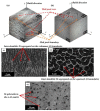Advancements in the Additive Manufacturing of Magnesium and Aluminum Alloys through Laser-Based Approach
- PMID: 36431608
- PMCID: PMC9698782
- DOI: 10.3390/ma15228122
Advancements in the Additive Manufacturing of Magnesium and Aluminum Alloys through Laser-Based Approach
Abstract
Complex structures can now be manufactured easily utilizing AM technologies to meet the pre-requisite objectives such as reduced part numbers, greater functionality, and lightweight, among others. Polymers, metals, and ceramics are the few materials that can be used in AM technology, but metallic materials (Magnesium and Aluminum) are attracting more attention from the research and industrial point of view. Understanding the role processing parameters of laser-based additive manufacturing is critical to maximize the usage of material in forming the product geometry. LPBF (Laser powder-based fusion) method is regarded as a potent and effective additive manufacturing technique for creating intricate 3D forms/parts with high levels of precision and reproducibility together with acceptable metallurgical characteristics. While dealing with LBPF, some degree of porosity is acceptable because it is unavoidable; hot ripping and cracking must be avoided, though. The necessary manufacturing of pre-alloyed powder and ductility remains to be the primary concern while dealing with a laser-based additive manufacturing approach. The presence of the Al-Si eutectic phase in AlSi10Mg and AlSi12 alloy attributing to excellent castability and low shrinkage, attaining the most attention in the laser-based approach. Related studies with these alloys along with precipitation hardening and heat treatment processing were discussed. The Pure Mg, Mg-Al alloy, Mg-RE alloy, and Mg-Zn alloy along with the mechanical characteristics, electrochemical durability, and biocompatibility of Mg-based material have been elaborated in the work-study. The review article also summarizes the processing parameters of the additive manufacturing powder-based approach relating to different Mg-based alloys. For future aspects, the optimization of processing parameters, composition of the alloy, and quality of powder material used will significantly improve the ductility of additively manufactured Mg alloy by the LPBF approach. Other than that, the recycling of Mg-alloy powder hasn't been investigated yet. Meanwhile, the post-processing approach, including a homogeneous coating on the porous scaffolds, will mark the suitability in terms of future advancements in Mg and Al-based alloys.
Keywords: aluminum; laser-based powder fusion; magnesium; mechanical characteristics; post-processing approach; processing parameters.
Conflict of interest statement
The authors declare no conflict of interest.
Figures




















Similar articles
-
A Review on Traditional Processes and Laser Powder Bed Fusion of Aluminum Alloy Microstructures, Mechanical Properties, Costs, and Applications.Materials (Basel). 2024 May 25;17(11):2553. doi: 10.3390/ma17112553. Materials (Basel). 2024. PMID: 38893817 Free PMC article. Review.
-
Additive manufacturing of Zn-Mg alloy porous scaffolds with enhanced osseointegration: In vitro and in vivo studies.Acta Biomater. 2022 Jun;145:403-415. doi: 10.1016/j.actbio.2022.03.055. Epub 2022 Apr 2. Acta Biomater. 2022. PMID: 35381400
-
Additively manufactured biodegradable Zn-Mn-based implants with an unprecedented balance of strength and ductility.Acta Biomater. 2025 Apr;196:506-522. doi: 10.1016/j.actbio.2025.02.047. Epub 2025 Feb 22. Acta Biomater. 2025. PMID: 39993520
-
Laser additive manufacturing of biodegradable magnesium alloy WE43: A detailed microstructure analysis.Acta Biomater. 2019 Oct 15;98:36-49. doi: 10.1016/j.actbio.2019.05.056. Epub 2019 May 25. Acta Biomater. 2019. PMID: 31132536
-
Research Progress on Laser Powder Bed Fusion Additive Manufacturing of Zinc Alloys.Materials (Basel). 2024 Aug 30;17(17):4309. doi: 10.3390/ma17174309. Materials (Basel). 2024. PMID: 39274701 Free PMC article. Review.
Cited by
-
Additive Manufacturing of Si-Added 7075 Aluminum Alloys: Microstructural, Mechanical, and Electrochemical Properties via Heat Treatment.Materials (Basel). 2025 Mar 28;18(7):1544. doi: 10.3390/ma18071544. Materials (Basel). 2025. PMID: 40271784 Free PMC article.
References
-
- Huang Y., Leu M.C., Mazumder J., Donmez A. Additive manufacturing: Current state, future potential, gaps and needs, and recommendations. J. Manuf. Sci. Eng. 2015;137:014001. doi: 10.1115/1.4028725. - DOI
-
- Dilberoglu U.M., Gharehpapagh B., Yaman U., Dolen M. The role of additive manufacturing in the era of industry 4.0. Procedia Manuf. 2017;11:545–554. doi: 10.1016/j.promfg.2017.07.148. - DOI
-
- Ghisellini P., Cialani C., Ulgiati S. A review on circular economy: The expected transition to a balanced interplay of environmental and economic systems. J. Clean. Prod. 2016;114:11–32. doi: 10.1016/j.jclepro.2015.09.007. - DOI
-
- Stock T., Obenaus M., Kunz S., Kohl H. Industry 4.0 as enabler for a sustainable development: A qualitative assessment of its ecological and social potential. Process Saf. Environ. Prot. 2018;118:254–267. doi: 10.1016/j.psep.2018.06.026. - DOI
Publication types
LinkOut - more resources
Full Text Sources

